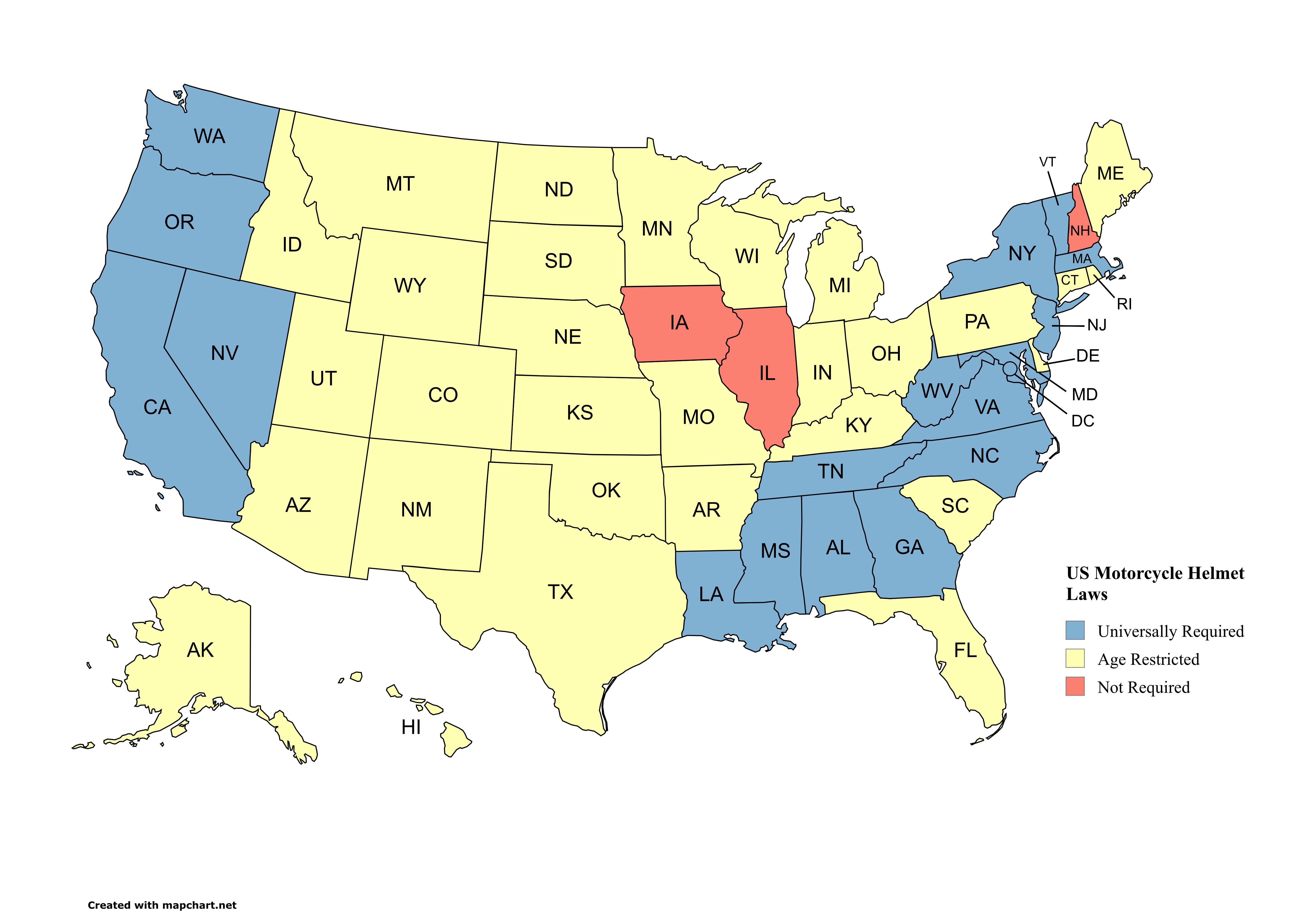US Motorcycle Helmet Laws Map


Alex Cartwright
Senior Cartographer & GIS Specialist
Alex Cartwright is a renowned cartographer and geographic information systems specialist with over 15 years of experience in spatial analysis and data...
Geographic Analysis
What This Map Shows
This map provides a clear and informative overview of motorcycle helmet laws across the United States. It categorizes each state based on its helmet law status, indicating whether the law mandates helmets for all riders, only for specific age groups, or if there are no helmet laws at all. Helmet laws not only apply to riders but also extend to passengers, creating a significant impact on road safety and rider behavior. Understanding these laws is crucial for motorcycle enthusiasts, safety advocates, and policymakers alike.
Deep Dive into Motorcycle Helmet Laws
Motorcycle helmet laws are a vital aspect of road safety in the United States. These laws are designed to protect riders from head injuries in the event of accidents, which can often be severe or fatal without proper headgear. According to the National Highway Traffic Safety Administration (NHTSA), wearing a helmet can reduce the risk of fatal injury by 37% for motorcycle riders. Interestingly, the effectiveness of helmets is supported by extensive research, which shows that helmets are instrumental in preventing traumatic brain injuries (TBIs).
The landscape of helmet laws in the U.S. is quite diverse. Some states enforce universal helmet laws, meaning every rider must wear a helmet, regardless of age. Examples of such states include New York and California, where strict regulations are in place to promote safety. On the other hand, many states have enacted partial helmet laws that require only certain age groups to wear helmets. For instance, in Florida, riders under the age of 21 must wear a helmet, while those 21 and older can ride without one if they have a certain level of insurance coverage or complete a safety course.
Moreover, a few states, such as Illinois and Iowa, have no helmet laws at all, allowing riders the freedom to choose whether or not to wear a helmet. This lack of regulation raises questions about safety and the responsibility of states to protect their citizens. The debate surrounding helmet laws often touches on personal freedom versus public safety, creating a complex dynamic that varies from one state to another.
Interestingly, some states with age-restricted laws also have additional requirements, such as mandatory training courses or specific insurance policies. This means that while adult riders might have the option to ride without a helmet, they must meet certain criteria to do so safely. For example, in Michigan, riders over 21 are not required to wear helmets if they have a minimum of $20,000 in medical coverage.
Regional Analysis
When examining the map, we can see distinct regional patterns in helmet laws across the United States. The Northeast generally has stricter helmet laws compared to the South and West. For example, states like Massachusetts and New Jersey enforce universal helmet laws, prioritizing rider safety. In contrast, states such as Texas and South Carolina have partial laws, allowing adults to ride without helmets if they meet specific conditions.
The Midwest presents a mixed bag of regulations. For instance, Ohio has a partial helmet law, requiring riders under 18 to wear helmets, while adults have the option to ride without one. This inconsistency might confuse both residents and visitors, highlighting the importance of awareness and education about state laws.
Interestingly, states like California, which have stringent helmet laws, often report lower rates of motorcycle fatalities compared to states with more lenient regulations. In 2020, California recorded 353 motorcycle fatalities, while Florida, with its partial laws, had 581 fatalities, emphasizing the correlation between helmet laws and rider safety outcomes.
Significance and Impact
The significance of motorcycle helmet laws extends beyond individual states; they have profound implications for public health and safety nationwide. As motorcycle ridership continues to rise, understanding the impact of these laws is crucial for reducing fatalities and injuries. The NHTSA estimates that if all motorcyclists wore helmets, over 1,800 lives could be saved annually. This statistic alone underscores the importance of comprehensive helmet laws.
Moreover, the trend towards more lenient helmet laws in some states raises concerns about the long-term effects on rider safety. As advocacy groups push for stricter regulations, the conversation around helmet laws is likely to evolve, influenced by shifts in public opinion and the latest safety data.
In conclusion, the landscape of motorcycle helmet laws in the U.S. is complex and varied, reflecting broader societal values regarding safety, personal freedom, and responsibility. As riders, passengers, and policymakers navigate this terrain, it's essential to stay informed and proactive about safety measures that can save lives on the road. Have you considered how your state's helmet laws impact your riding experience? Understanding the legal framework surrounding motorcycle riding can enhance safety and promote a responsible riding culture.
Visualization Details
- Published
- September 4, 2025
- Views
- 94
Comments
Loading comments...